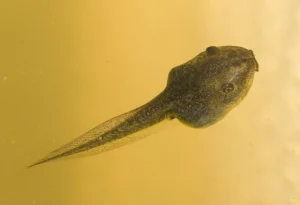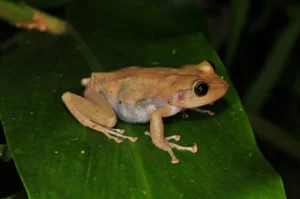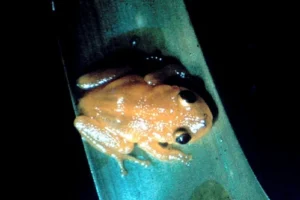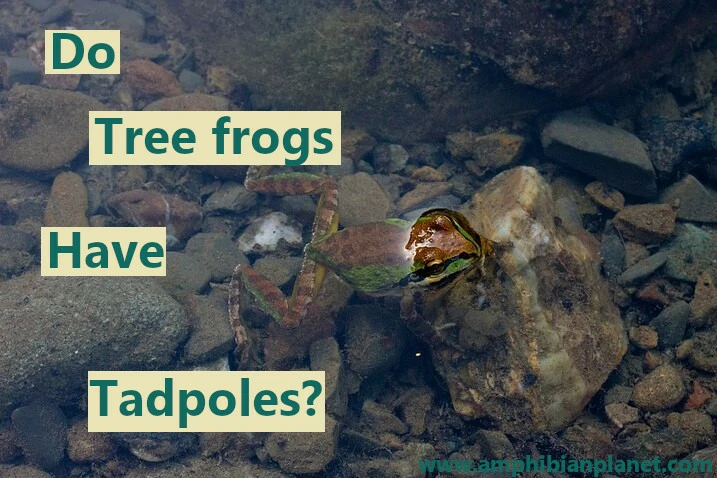Tree frogs are highly adapted for their life in or around trees. Some tree frog species such as the Amazon milk frog live nearly their entire lives high up in the forest canopy, rarely, if ever coming down to the ground. But do tree frogs have tadpoles?
Most tree frog species lay eggs, which hatch into tadpoles. These tadpoles will metamorph into mature tree frogs over time. However, some tree frog species such as the common coquí do not have a tadpole stage. These frogs lay eggs, which hatch into fully-developed froglets.
Tree frogs that do not have a tadpole stage usually lay their eggs away from water bodies. This could be in tree holes, in damp leaf litter, in moist soil, in caves, or even in abandoned bird nests (depending on species).
In many species, the male or female (sometimes both) will stay with eggs to protect them from predators and provide moisture for the eggs by brooding them.
The skin contact keeps the eggs moist – and during very dry periods, these frogs will leave and head to the water to gather more moisture for their eggs.
Most Tree Frog Species Have a Tadpole Stage
Most tree frogs lay eggs in shallow ponds, seasonal pools, or other shallow water bodies. Some species such as the red-eyed tree frog lay their eggs on leaves hanging over ponds.
Others such as bromeliad tree frog or Amazon milk frog lay their eggs in puddles that collect in the holes of trees, and water-holding plants such as bromeliads.
After a few days, to a few weeks, tiny tadpoles hatch from these eggs. Tadpoles are very different from adult tree frogs; this is because they’re adapted for a fully aquatic life (life in the water), while adult tree frogs are adapted for a mostly arboreal life (life in or around trees).

Tadpoles have external gills and a flat paddle-like tail fin for life in the water. They use their gills to breathe underwater, just like fish.
After a few weeks, these tadpoles will go through a process known as metamorphosis and transform into miniature tree frogs that live on land.
During this process;
- They lose their gills and get well-developed lungs for breathing air
- The tail shortens and is eventually absorbed into the body
- They develop strong legs for moving on land
Once this process is complete, tiny froglets (small frogs), typically half an inch long will leave the water and live a fully terrestrial life.
These froglets will grow into adult tree frogs and once they mature, they will go back to aquatic habitats to breed and lay their eggs.
Some Tree Frogs Do Not Have a Tadpole Stage
Some tree frogs, such as the common coquí evolved to live in environments with low availability of undisturbed surface water suitable for tadpoles to live in.
For this reason, they developed unique breeding strategies that do not involve a tadpole stage.

These tree frogs do not have tadpoles. They lay their eggs away from water – which then hatch into young fully developed tree frogs.
The eggs are laid in protected areas such as tree holes, the petioles of rolled palms, and abandoned bird nests.
Some species such as the Rio Grande chirping frog also lay their eggs on the ground, usually under damp leaf litter, or under the surface of moist soil. Counou robber frogs lay their eggs in caves and other rock crevices.
Most species only breed in specific types of habitats. For example, common coquis lay their eggs exclusively in trees and other plants in the forest canopy.
On the other hand, red-eyed coquis and Rio Grande chirping frogs exclusively lay their eggs under damp litter, or in moist soil on the ground.
A few tree frog species without a tadpole stage are:
- Common Coqui
- Cochran’s trees frog
- Red-eyed coqui
- Treehole coqui
- Cricket coqui
- Counou robber frog
- Patternless whistling frog
- Abbott’s robber frog
- South Island telegraph frog
- Puerto Rican wetland frog
- Puerto Rican rock frog
A Few Tree Frog Species Give Birth to Live Young
A few tree frog species such as the Golden coquí found in Puerto Rico do not lay eggs, but instead give birth to live young.

When Golden coquís mate, their eggs are fertilized internally and are retained within a uterus formed of fused portions of the oviducts.
The developing embryos are nourished by the egg yolks, and after about a month, the female will give birth to 3 – 6 fully developed frogs. This is known as “Ovoviviparity.”
Since these tree frogs give birth to live young, they do not have a tadpole stage.
Having a Tadpole Stage Has Disadvantages
The tadpole stage is the most vulnerable stage of most frogs’ lives. Frogs often lay eggs in temporary pools of water, and sometimes, these pools dry up before the tadpoles have had enough time to metamorph into adults.
Also, its common for many frogs lay eggs in the same pools, and when the eggs hatch, the pool will be crowded. This means the tadpoles have to compete for space and other limited resources.
Overcrowding often leads to cannibalism in which large tadpoles eat small, vulnerable tadpoles. For example, large cane toad tadpoles have been documented eating smaller tadpoles of their own species.
Tadpoles are also preyed on by fish, adult frogs and toads, salamanders, newts, birds, snakes and other reptiles, many mammals, and even predatory insects such as water boatmen and dragonfly larvae.
For these reasons, it’s common for over 90% of tadpoles in a pond to be wiped out before they can undergo metamorphosis and transform into adult frogs.
Some Tadpoles Can Defend Themselves From Predators
Due to their high vulnerability to predators, many species of tadpoles have developed several ways to defend themselves.
When a predator has been detected, most tadpoles will dive to the bottom of the water and hide among aquatic plants. They then blend into their environment, escaping the notice of the predator.
Some tadpoles, like those of the American toad, also avoid predators by swimming in very shallow water, and by swimming close together in schools during the day.
Some tadpoles, such as those of the European common frog and the Moor frog grow longer tails when in the presence of predators. With longer tails, the tadpoles swim faster and are better at avoiding predators.
Conclusion
Tree frogs are found on every continent, excluding Antarctica. With this wide distribution, they live in a very wide range of habitats, from humid forests, to dry regions.
Different tree frog species have adapted breeding strategies that are practical for the areas they live in.
Most tree frogs have tadpoles, which develop and metamorph into adult tree frogs over time. However, some species do not have a tadpole stage.
They lay their eggs in terrestrial environments, which then hatch into fully developed young tree frogs.


